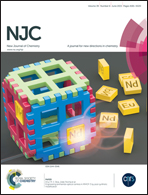Color tuning in thermally stable Sm3+-activated CaWO4 nanophosphors†
Abstract
This paper reports CaWO4:Sm3+ nanophosphors with varying compositions of Sm3+ (Sm3+ = 2, 5, 7 and 10 at%). As-prepared (ASP) samples were annealed at 800 °C for 2 h to eliminate unwanted organic moieties present in the sample and to improve crystallinity. These nanoparticles are characterized employing X-ray diffraction (XRD), differential thermal analysis (DTA), thermogravimetric (TG) analysis, Fourier-transform IR spectroscopy (FT-IR), transmission electron microscopy (TEM), X-ray photoelectron spectroscopy (XPS), UV-vis spectroscopy, Raman spectroscopy, photoluminescence studies and lifetime decay studies. The as-prepared samples exhibit a spherical morphology having particle sizes of ∼18 to 25 nm. TG study reveals that the nanophosphors are thermally stable. Excitation spectra corroborate that these were sufficiently excited over a broad wavelength range (250–405 nm). As-prepared and 800 °C annealed samples of CaWO4:Sm3+ (Sm3+ = 2, 5, 7 and 10 at%) nanoparticles show blue and green luminescence because of strong host contribution, and warm white luminescence because of different energy transfer rates from host to Sm3+ ions under 250 and 405 nm excitations, respectively. This color tunability is also verified by the CIE diagram. The critical distances Rc were found to be ∼19.58 and 19.62 Å for ASP and 800 °C annealed 2 at% Sm3+-doped CaWO4, respectively. Using Van Uitert's model the type of interaction between Sm3+ ions was confirmed as a dipole–dipole interaction. The CCT (Color Correlated Temperature) values under 405 nm are in the range ∼1950 to 2900 K. These studies reveal that the emission colors can be effectively tuned by altering the excitation wavelength and annealing temperature, and these materials may be potential candidates for white light emitting diodes.


 Please wait while we load your content...
Please wait while we load your content...